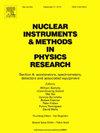Development of the machine learning-based online trigger algorithms for heavy flavor events selection in sPHENIX experiment
IF 1.5
3区 物理与天体物理
Q3 INSTRUMENTS & INSTRUMENTATION
Nuclear Instruments & Methods in Physics Research Section A-accelerators Spectrometers Detectors and Associated Equipment
Pub Date : 2025-03-23
DOI:10.1016/j.nima.2025.170435
引用次数: 0
Abstract
The sPHENIX experiment at the Relativistic Heavy Ion Collider (RHIC) is designed to investigate the physics of the strongly coupled Quark–Gluon Plasma (QGP). Heavy-flavor hadrons serve as key probes of the QGP produced during heavy-ion collisions. However, the current readout event rate of the sPHENIX detector is limited to 15 kHz, due to constraints in the readout system of the outer calorimeter detectors. To improve the trigger efficiency of heavy-flavor events, a dedicated online trigger system is imperative. This paper presents the design of machine learning-based online trigger algorithms aimed at selecting heavy-flavor quark events in the sPHENIX experiment. The algorithms, primarily based on Multi-Layer Perceptrons, Graph Neural Networks, and Bipartite Graph Neural Networks, use only spatial track hit information from fast silicon detectors as input. The performance of these algorithms are evaluated using simulation datasets, with charm-quark event samples generated via Monte Carlo for p+p collisions at = 200 GeV. The results demonstrate that the system achieves a track reconstruction efficiency of 0.945. Additionally, the precision and recall values for identifying heavy-flavor events are both around 0.79.
sPHENIX实验中基于机器学习的重味事件选择在线触发算法的开发
在相对论重离子对撞机(RHIC)上进行的sPHENIX实验旨在研究强耦合夸克-胶子等离子体(QGP)的物理特性。重味强子是重离子碰撞过程中产生的QGP的关键探测器。然而,由于外部量热计探测器读出系统的限制,sPHENIX探测器的当前读出事件率被限制在15 kHz。为了提高重味事件的触发效率,一个专用的在线触发系统势在必行。提出了一种基于机器学习的在线触发算法,用于sPHENIX实验中重味夸克事件的选择。该算法主要基于多层感知器、图神经网络和二部图神经网络,仅使用来自快速硅探测器的空间轨迹命中信息作为输入。使用模拟数据集对这些算法的性能进行了评估,并通过蒙特卡罗生成了s = 200 GeV的p+p碰撞的粲夸克事件样本。结果表明,该系统的航迹重建效率为0.945。此外,识别重口味事件的精度和召回值都在0.79左右。
本文章由计算机程序翻译,如有差异,请以英文原文为准。
求助全文
约1分钟内获得全文
求助全文
来源期刊
CiteScore
3.20
自引率
21.40%
发文量
787
审稿时长
1 months
期刊介绍:
Section A of Nuclear Instruments and Methods in Physics Research publishes papers on design, manufacturing and performance of scientific instruments with an emphasis on large scale facilities. This includes the development of particle accelerators, ion sources, beam transport systems and target arrangements as well as the use of secondary phenomena such as synchrotron radiation and free electron lasers. It also includes all types of instrumentation for the detection and spectrometry of radiations from high energy processes and nuclear decays, as well as instrumentation for experiments at nuclear reactors. Specialized electronics for nuclear and other types of spectrometry as well as computerization of measurements and control systems in this area also find their place in the A section.
Theoretical as well as experimental papers are accepted.

 求助内容:
求助内容: 应助结果提醒方式:
应助结果提醒方式:


